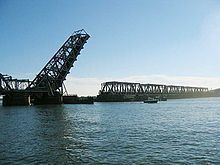Carries Northeast Corridor Owner Amtrak Opened 1907 Location Old Saybrook Body of water Connecticut River | Crosses Connecticut River Longest span 161 feet (49 m) Total length 506 m Material Steel | |
 | ||
Locale Old Saybrook, Connecticut to Old Lyme, Connecticut Design Truss bridge with a bascule span Bridge type Truss bridge, Bascule bridge Similar Pequonnock River Railroad, Bascule bridge, Thames River Bridge, Raymond E Baldwin Bridge, Norwalk River Railroad | ||
The Amtrak Old Saybrook – Old Lyme Bridge is the last crossing of the Connecticut River before it reaches Long Island Sound. It is a Truss bridge with a bascule span, allowing boat traffic to go through. Its tracks are owned by Amtrak and used by trains on their Northeast Corridor and Shore Line East high-speed rail lines. It can be seen from the Raymond E. Baldwin Bridge (Interstate 95 and U.S. Route 1), as well as from various points on Route 154.
Contents
Construction and operational history
Also known as the Connecticut River Railroad Bridge and Connecticut River Bridge, it was built in 1907 by the Scherzer Rolling Lift Bridge Company of Chicago, for the New York, New Haven and Hartford Railroad. It replaced an earlier bridge, built in 1870. It is similar in design to the Housatonic River Railroad Bridge further south, though shorter in overall length. It also lacks the latter bridge's parallel sets of spans, although the abutments and piers were designed to carry such extra spans (for four total tracks) which were never installed at this location.
The bridge underwent a structural rehabilitation in 1976, and had mechanical and electrical rehabilitation in 1981 and 1997. In 2000 the bridge experienced a major electrical failure which rendered the drawspan stuck in the open position (blocking railroad traffic). The bridge became stuck in the closed position twice in 2001. A 2006 inspection found the bridge to be structurally deficient and determined that periodic rehabilitation work was no longer sufficient to keep the century-old bridge functional.
Historic status designation
The bridge was determined to be eligible for listing on the National Register of Historic Places in 1987, but it was not finally listed due to owner objection, with decision noted in National Register reference number #87002125.
It is one of eight moveable bridges on the Amtrak route through Connecticut surveyed in one multiple property study in 1986. The eight bridges from west to east are: Mianus River Railroad Bridge at Cos Cob, built in 1904; Norwalk River Railroad Bridge at Norwalk, 1896; Saugatuck River Railroad Bridge at Westport, 1905; Pequonnock River Railroad Bridge at Bridgeport, 1902; Housatonic River Railroad Bridge, at Devon, 1905; this Connecticut River Railroad Bridge, Old Saybrook-Old Lyme, 1907; Niantic River Bridge, East Lyme-Waterford, 1907; and Thames River Bridge (Amtrak), Groton, built in 1919.
Replacement
The structurally deficient bridge is planned for replacement around 2020. An Environmental Assessment released in May 2014 identified two preferred alternatives: a bascule bridge similar in size to the existing span, or a vertical lift bridge with possibly increased clearances. Either option would be built on a parallel alignment 48 feet (15 m) south of the existing bridge. Fully high-level designs without movable sections were eliminated from consideration due to the massive approaches that would have to be built, which would have major impacts on nearby wetlands and increase construction and land acquisition costs.
